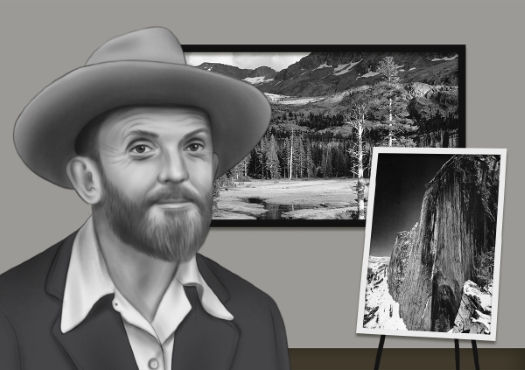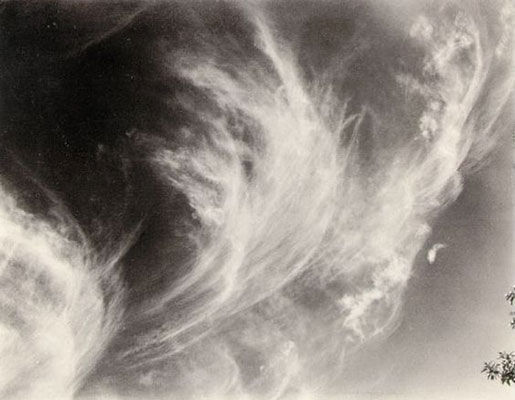Summary of Ansel Adams
Ansel Adams was the most important American landscape photographer of the 20th century. He might also be the most widely known and respected of all American photographers, whose legend continues through books and television documentaries, and through the prevalent reproduction of his work on calendars, posters, postcards and other ephemera. Adams's professional life was dedicated to capturing through his lens the forgotten and unspoiled wilderness of America's national parks and other protected conservation areas in the West. He was a committed environmentalist and nothing short of an icon for the 20th century conservation movement.
Adams and his friend and colleague Edward Weston founded Group f/64 whose commitment to the idea of a pure, or "higher", photography helped shape the history of early-to-mid 20th century modernism and secured photography's place - as fine art - within it. Adams himself was a highly accomplished technician. He published books - or manuals - on the technical aspects of photography and he used his own portfolios to help lobby politicians for the creation and upkeep of American National Parks. In 1952, with Beaumont and Nancy Newhall, Dorothea Lange, Minor White and others, Adams co-founded the photography quarterly, Aperture which was part of Adam's career-long mission (started with Group f/64) to promote the merits of serious, contemplative, photographic art. Aperture still publishes to this day.
Accomplishments
- In the mid-19th century, the painted American landscape was most readily associated with the so-called Hudson River School. The School tended towards idyllic tableaus showing scenes of calm pastoralism. It was a style disparaged (albeit somewhat harshly) by modernists who thought the Hudson tradition in photography merely reinforced the conservative taste for wistful picture narratives. Adams believed that, if approached in a spirit of the age of modernity, landscape photography might in fact match music or poetry in its potential to stimulate a sense of higher contemplation in the spectator. Adams's goal then was to capture the true majesty of the natural world within a single frame and, if he could achieve this using a combination of technical skill, dogged leg-work and intuition, then the better the chances of producing landscapes that were more than just pictorial.
- Though his fame is founded on his iconic American landscapes, Adams also produced a small number of still life studies. Like his landscapes, Adams brought a modern sensibility to what was a traditional painterly genre. Without distorting the objects in front of his lens (as was, say, Weston's preference), Adams used sharp focus to emphasize primary elements and relations between objects that might have ordinarily gone unnoticed. In this sense he demonstrated how the photographer could invite the spectator to consider the beauty of everyday things by using the camera to remove, or "liberate", the objects from their original setting.
- As co-founder and active member of Group f/64, Adams and his colleagues took Paul Strand's Straight Photography principles and customized them to the ends of promoting a higher art. Whereas Strand's images were flat (by design), Adams's were all about ultra-sharp depth of field (the appellation f/64 was an optical reference to the aperture setting (f/64) that produced the finest picture detail). However, Adams brought an added level of personal commitment to his technical know-how. Led by his affinity with the natural world, he would often trek between dawn and dusk in order to find the right location from which to secure his images.
- Adams was known not just for the brilliance of his images, but for his technical expertise too. His book Making a Photograph (1935) was a highly distinguished instructions manual illustrated with his own prints. It was through his pursuit of technical mastery indeed that Adams and Fred Archer developed what became known later as the "Zone System," a method by which the photographer could "pre-visualize" the tonal quality of the final image at the very point of taking the picture.
The Life of Ansel Adams
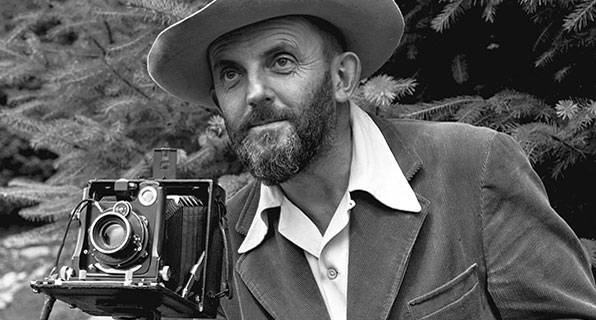
The love of the outdoors and the joy of recording nature made Ansel Adams the quintessential landscape photographer of the 20th century.
Important Art by Ansel Adams
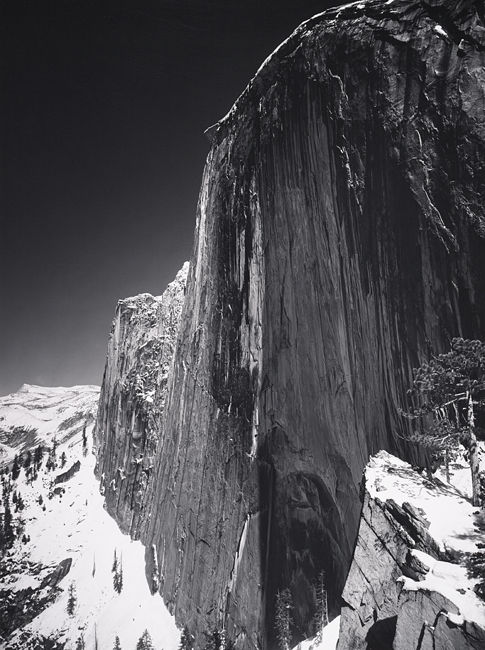
Monolith, the Face of Half Dome, Yosemite National Park
A dark and brooding image of the Half Dome in Yosemite National Park, Monolith is a high contrast black and white photograph in sharp and deep focus (from foreground to background). Less a representation of how the landscape looked at that precise moment than a dramatic rendering of the photographer's emotions upon viewing the scene, the Half Dome image is amongst Adams's best known, and most important, photographs. He later said of this image: "The great rocks of Yosemite, expressing qualities of timeless, yet intimate grandeur, are the most compelling formations of their kind. We should not casually pass them by for they are the very heart of the earth speaking to us."
Moved by the Yosemite landscape, Adams hoped to use his camera to capture his own feelings towards this magnificent natural environment. According to Adams scholar Anne Hammond, "Opposite the cliff and halfway to the top, the ground glass gave a view as close as one could get to the physical experience of climbing the sheer rock-face. The slight perspective distortion of the extreme oblique view compressed the Dome into a vertical tower, emphasized by the line of shadow in the center." In bringing together the face of the half dome, an emblem of the Yosemite Valley, and the High Sierras beyond, "the Half Dome stands like a great headstone, [a] symbol of the insurmountable fact of mountain experience."
The photograph was taken from a vantage point known as the Diving Board, a granite slab that hangs 3,500 feet above the valley floor. Adams had been searching for a view of the Half Dome that also conveyed his sense of wonder. By the time he reached the Diving Board, Adams had only two glass plate negatives left in his satchel. The first of the two was exposed with a yellow filter that he knew would darken the sky slightly. With the second, Adams used a dark red filter that significantly darkened the sky and subsequently emphasized the white snow and gleaming granite of the half dome. The resulting photograph marked a turning point in Adams's work: he had effectively previsualized what the photograph would look like before he pressed down on the shutter. He would later explain that "this photograph represents my first conscious visualization; in my mind's eye I saw (with reasonable completeness) the final image as made." In the years that followed, Adams would refine his ideas about previsualization in what he later called the "Zone System."
Gelatin Silver Print - Collection Center for Creative Photography, The University of Arizona
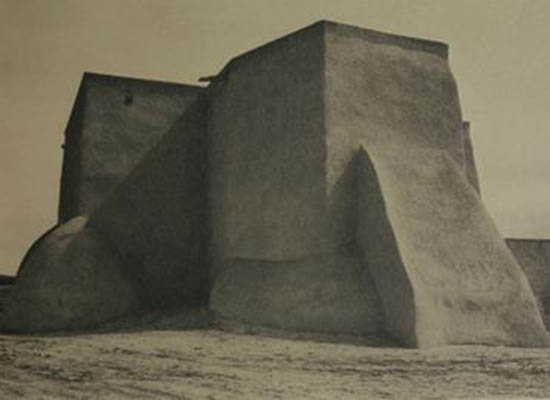
St. Francis Church, Ranchos de Taos, New Mexico
In the spring of 1929, Adams and his wife Virginia spent several months with writer Mary Austin in Santa Fe, New Mexico. It was during this trip that Adams and Austin decided to collaborate on a book about Santa Fe and the surrounding area. Austin introduced Adams to Mabel Dodge Luhan, the Santa Fe arts patron who was hosting artists of the caliber of Georgia O'Keeffe around the same time. Luhan was married to Tony Lujan, who was a member of the Taos tribal council and it was he who gave Adams permission to photograph at the Taos Pueblo.
A somewhat transitional photograph for Adams, St. Francis Church, Ranchos de Taos, New Mexico, is a rare soft-focus image of the angular white-washed church bathed in soft light and shadow. While illustrating his obvious concern with form and the effects thereon of natural light, this image makes clear that even as late as 1929, Adams was working with a soft focus, and with textured paper. Both of these practices were in keeping with the (later scorned) Pictorialist method. Indeed, this, and other photographs from the limited-edition book, Taos Pueblo (1930), were printed on special Dassonville paper that was rag-based and warm in tone. The upshot was a collection of images (like St. Francis Church) that lacked the sharp focus and glossy paper characteristics that marked his later photographs (or, for that matter, some earlier images, including Monolith, The Face of Half Dome). With prose by Austin, the book included photographic prints rather than reproductions of Adams's Taos photographs.
Gelatin silver print - From the limited-edition book Taos Pueblo, 1930
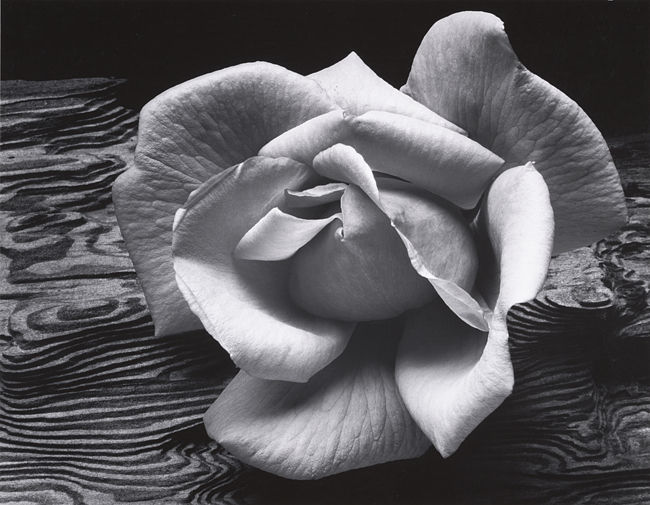
Rose and Driftwood, San Francisco, California
In Rose and Driftwood, Adams made use of sharp focus and high contrast to depict the delicate veins of the rose and the raised striations of the driftwood. The resulting image is a strikingly modern interpretation of the traditional still life. Unlike his contemporary Edward Weston, who preferred to isolate objects by physically removing them from their surroundings, Adams married the rose with the wood on which it was placed. Drawing on his experience of photographing landscapes - imparting on him an eye for texture, contrast, composition, and an emotional connection with his choice of subject matter - Adams treats the rose and driftwood in much the same way, using the concentric circles of the driftwood and the rose rising from its surface like elements found in nature.
Adams met Weston in 1927 and Paul Strand in 1930, both of whom excelled at the modern photographic still life. Although he was critical of Weston's extreme close-up photographs of objects (including his famous Pepper (1930)) Adams was impressed by Strand's use of Straight Photography to render the natural world. And it was through Strand that Adams began to understand that photography could be used as an expressive art form in its own right. Although Adams had already received some measure of success in photography, but following his meeting with Strand, he discarded altogether the soft focus and textured paper, and began working rather with a smooth, glossy paper that enabled the sharp detail he now strived for in his negatives. This photograph, and others from this period, mark Adams's shift towards Straight Photography. The same year (1932) Adams, Weston, Imogen Cunningham, and others formed the Group f/64, which dedicated itself to the furtherance of photography as fine art.
Gelatin silver print - Collection Center for Creative Photography, The University of Arizona
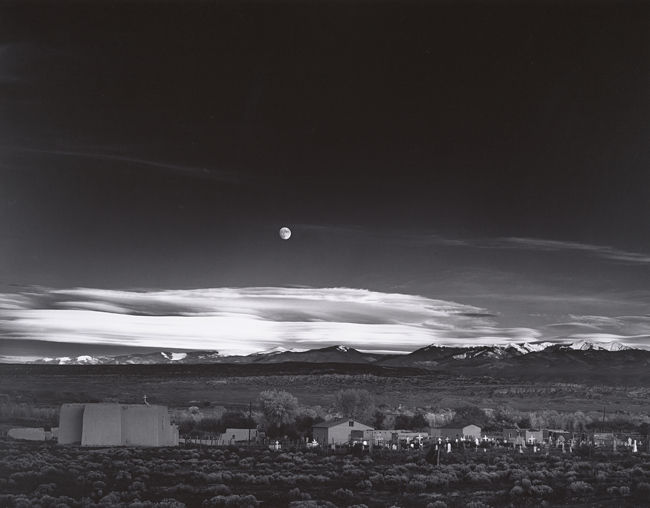
Moonrise, Hernandez, New Mexico
One of Adams's most famous photographs, and one of the most iconic photographs of the modern era, Moonrise, Hernandez, New Mexico, is a dramatic image of a moon rising over the small southwest town, near Santa Fe. A scene that is momentarily both dark and light, Moonrise, shows the town's buildings bathed in late evening light just moments before the sun will set and darkness will envelop the town. Here Adams approached photography as he would a piece of music, interpreting the negative and print like a conductor interprets a score. Adams often repeated the mantra that "a photograph is made, not taken" and in this regard, as Anne Hammond has noted, "the technical controls that Adams had perfected enabled him to realize [...] the mortality of individual human existence confronting the eternity of the universe, the theme of life and death."
The story of the photograph's creation has become the stuff of myth. The story goes that Adams happened on the scene, which he later called "an inevitable photograph," while driving home from Santa Fe. He later recalled rushing to stop the car and pulling out his 8 x 10 camera and gathering the appropriate lens and filter only to realize that he could not find his light meter. The situation was made all the more dramatic because the sun would soon be setting and the light illuminating the cemetery crosses in the foreground would be gone. Adams used his technical skill and knowledge of exposure to approximate the correct exposure for the photograph based only on the luminosity of the moon. Utilizing his Zone System he determined the tonal range (from white to black) in order to previsualize the final print. This method allowed him here to visualize the negative and the tonal range of the various elements in the image - the white crosses in the foreground, the dark sky and rising moon - before choosing the exact moment to release the shutter.
Gelatin silver print - Collection Center for Creative Photography, The University of Arizona
Grand Teton and Snake River, Wyoming
In 1941, at the height of World War II but before the bombing on Pearl Harbor, Adams received a commission from the U.S. Department of the Interior to photograph National Parks and other notable landscapes. In exchange for film, paper, and darkroom chemicals, and a day rate of $20, Adams would provide photographic murals for display in the halls of the Department of Interior. Although Adams took some 225 photographs for the project (including this image), the project was later dropped (never to be resumed) due to America's sudden involvement in the war.
Grand Teton is a masterful photograph that draws the viewer's eye from the river in the foreground, around the bend to the snow-capped mountains of the Grand Teton, and up towards the brooding sky in the background. Adams's vivid landscape makes use of sharp focus and natural light to capture the true splendor of the National Parks. As Adams said of his vista: "The grand lift of the Tetons is more than a mechanistic fold and faulting of the earth's crust; it becomes a primal gesture of the earth beneath a greater sky." Adams, who was always more drawn to the natural world than the people in it, was criticized however for ignoring political events at home and abroad, most famously by Henri Cartier-Bresson. "The world is going to pieces," Cartier-Bresson chided "and people like [Ansel] Adams and Weston are photographing rocks!"
Gelatin silver print - Victoria and Albert Museum, London
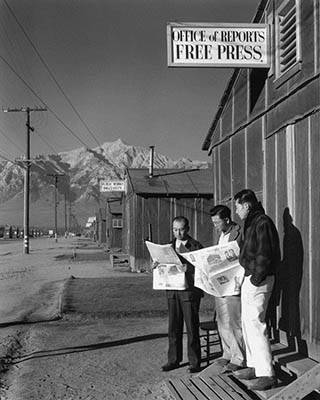
Roy Takeno, Editor, and Group Reading Paper in Front of Office, Manzanar Relocation Center, California
Three months after the attack on Pearl Harbor in December of 1941, an Executive Order was issued which decreed that all Americans of Japanese descent living in California, Oregon, and Washington would be housed in temporary internment facilities. The Manzanar Relocation Center was located in the Owens Valley, on the eastern base of the Sierra Nevada mountains. Adams was invited to document life in the camp and travelled to Manzanar on two occasions: October 1943 and July 1944.
A rare foray by Adams into documentary photography, Roy Takeno, Editor, and Group Reading Paper in Front of Office, shows three American-Japanese men reading the local newspaper on the steps of the Free Press Office. Carefully composed to spotlight the figures in the foreground, the men are framed against nondescript buildings in the middle foreground, while the snowy peaks of the Sierra Nevada mountains occupy the horizon. With a composition that brings everything within the picture frame into sharp focus, the photograph accords with the principles of Straight Photography. Yet Adams's documentary image gives us little indication that the blameless men have been impounded. Indeed, Adams's Manzanar photographs were harshly criticized by his colleague Dorothea Lange for ignoring the injustices perpetrated on the citizens interned there. Photography curator John Szarkowski read the image differently, however, suggesting Adams had wanted to show that "in spite of the injustices they suffered, [Japanese-Americans] had maintained their cohesion, their dignity, and their will."
Adams's Manzanar photographs were published by U.S. Camera as Born Free and Equal in 1944 and appeared the same year at the Museum of Modern Art in an exhibition entitled "Manzanar." Whatever one's take on his approach, Adams himself had long been frustrated by his inability to contribute to the war effort (due to his age) and he hoped that his photographs, which were also circulated as a traveling exhibition by the Museum of Modern Art, would contribute by highlighting the injustice facing Japanese-Americans living on the west coast. (It is an interesting aside that the camp was home to Toyo Miyatake, a professional Japanese-American photographer who operated a studio at Manzanar and documented daily life within Manzanar from the viewpoint of the internees.)
Gelatin silver print
Biography of Ansel Adams
Childhood
Ansel Easton Adams was born on the 20th of February 1902, in San Francisco. He was the only child of Charles Hitchcock Adams and Olive Bray. Charles was a successful businessman but the family were already sheltered financially due to Ansel's paternal grandfather who was a wealthy timber baron. The family lived the Californian idyll in a house looking beyond sand dunes onto the Pacific Ocean. However, in 1907 the family lost most of their wealth in the financial crisis. Charles tried in vain to rebuild the family fortune, but their changed financial situation put a new strain on a family residence that was also home to Olive's sister and her elderly father. Ansel's mother grew somewhat ambivalent towards her son and so it fell to Charles to nurture his son's latent talents and interests.
Adams did not adapt to school life. He was a painfully shy boy and his sensitivity was not helped by a badly disfigured nose which he acquired, aged just four, following a serious fall during the 1906 San Francisco earthquake. His low self-esteem was only made worse by teasing and bullying from classmates and, having moved schools several times, his father took the decision to have his son privately tutored. During these formative years Adams often took solace in nature, becoming lost in long walks in the forest and among the sand dunes that abutted the family home. At the age of twelve, Adams found a new distraction in the piano. He taught himself to read music and very soon, he was taking formal piano lessons. His enthusiasm for music led to a dogged pursuit of a career as a concert musician that would continue into his mid-twenties. Throughout the 1920s Adams pursued music and photography equally, though still holding on to the hope that he might soon make the grade as a concert pianist. Despite his best efforts, it became increasingly clear that he did not have what it took to be a professional musician.
Adams's passion for music, and the personal discipline that demanded of him, would transfer then to his other creative pursuit, photography. Indeed, Adams believed that photography could give vent to the same feelings he experienced through his music. His first attraction to photography came indeed through his love of the natural landscape and a yearning to capture something of that overwhelming experience on film. That process had been set in motion when, aged 14, Adam was given a Kodak No. 1 Box Brownie Camera ahead of family trips to Yosemite National Park and the Sierra Nevada Mountains.
Early Training and Work
Adams joined the Sierra Club in 1919, an environmental organization founded in 1892 by conservationist John Muir. Soon thereafter, he was given a summer job as custodian of the LeConte Memorial Lodge, the Club's headquarters in Yosemite. The lodge would provide the 17-year-old Adams with accommodation during summer trips to Yosemite and he would accompany the Lodge on its annual trips in the Sierra Nevada, producing a series of photographic portfolios on its behalf. Most of his early photographs were landscapes viewed on memorable climbs. Indeed, the Sierra Club was instrumental to Adams's early success as an exhibiting photographer. They published his first photographs and writings in a 1922 bulletin and gave Adams his first solo exhibition at their headquarters in San Francisco in 1928. Six years later he was elected to the Sierra Club's board of directors.
In 1926 Adams met the philanthropist Albert Bender. Bender, who was to become Adams's first benefactor, was well connected within San Francisco's community of writers and artists and it was he who suggested to Adams that he create a saleable portfolio of his mountain pictures. The portfolio of eighteen prints was titled Parmelian Prints of the High Sierras (1927) and was printed in an edition of 100. It included Monolith, The Face of the Half Dome, which Adams considered to be his first truly important photograph. Bender had been so invested in Adams's talent in fact that he bought the first ten portfolios for himself and sought out buyers for the remainder. Adams's friendship with Bender would also bring him into contact with other artists and photographers, including the photographer Edward Weston, who he met at Bender's home in 1927.
Following a long courtship (he had practiced his piano in her family home) Adams married Virginia Best, an aspiring singer and the daughter of landscape painter Harry Best, in 1928. The couple had two children (a girl, Anne, and a boy, Michael). Virginia's father owned a gallery in Yosemite, where Adams would later exhibit his photographs. Virginia, who acted as producer, archivist and proofreader for her husband, later inherited the gallery from her father and the family continued to run the gallery until 1971 (it has since changed its name to the Ansel Adams Gallery and is still in operation today).
Mature Period
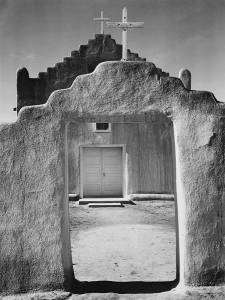
Adams first visited Taos, New Mexico in 1930, and returned on numerous occasions to photograph the landscape and architecture of the Southwest.
In 1930, while on a trip to Taos Adams met American photographer Paul Strand, the architect of so-called Straight Photography. Their meeting proved to be a decisive moment for Adams who was won over by Strand's modernist approach to his art. With Straight Photography, Strand had advocated the use of large format (over hand-held) cameras to create finely detailed, high contrast, flat images with the end-goal of producing semi-abstractions and/or geometric repetitions within the picture frame. Strand's images were reliant moreover on size and context for their full effect and his images were always intended to be hung on the walls of dedicated photographic galleries. After his meeting with Strand, and having viewed with admiration some of his recent New Mexico negatives, Adams returned to San Francisco ready to devote his life and career to the art of photography.
Adams's reputation soared in 1931 following his first solo exhibition, featuring sixty of his photographs of the Sierra Nevada mountains, at the Smithsonian in Washington, DC. The following year Adams travelled to New York where he met Alfred Stieglitz, known as the father of modern American photography, at his famous gallery An American Place. At their appointment, Stieglitz is said to have looked through Adams's portfolio twice, and in total silence, before telling Adams that his were some of the best photographs he had ever seen. The two became close friends, corresponding frequently about photography and other matters of mutual interest. Adams held an exhibition at An American Place in 1936, the first solo exhibition by a photographer since Paul Strand had exhibited there some 20 years earlier.
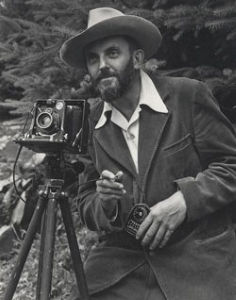
In 1932, Adams founded Group f/64 with Edward Weston. Active between 1932 and 1935, f/64 comprised a group of photographers - including Imogen Cunningham, Willard Van Dyke, Consuelo Kanaga, Henry Swift, Alma Lavenson, and Sonya Noskowiak - that advocated Straight and unmanipulated photography over Pictorialism. Pictorialism favored traditional, soft-focus images, which were printed from manipulated negatives that produced prints more reminiscent of oil paintings than photographs. The group's name, f/64, referred to their use of the smallest aperture setting (f-stop) on a camera that created an image with the sharpest depth of field. This approach contradicted Strand's preference for flat images, but the members were still united in their drive to pursue a "pure" unmanipulated style of photography that was devoid of tricks and pictorial manipulation.
During the early 1930s Adams wrote for the magazine Camera Craft and published the influential book Making a Photograph (1935), in which he demonstrated a technical, but straightforward and approachable way of writing about photography. Making a Photograph was a great success and continued the newly established tradition of the photography manual. Illustrated with high quality reproductions of his photographs, and technical commentary about how to "make" (rather than "take") the best photographs, the book merely enhanced Adams's burgeoning reputation.
Later, in 1944, the book The American Annual of Photography 1944, Volume Fifty-Eight was published. The first essay in the book, which also featured examples of his photography, was Adams's "A Personal Credo, 1943". In the essay, Adams explained how the use of his "Zone System" allowed the photographer to pre-visualize the final image. "The Zone System" was described as a "tool" for controlling the picture image based on a foreknowledge of four interlocked variables that were unique to the medium of photography: sensitivity of the negative paper, exposure time, lighting and studio development. The "Zone System" was a way to measure gradations (ten in total) of natural light (0 = black; IX = white) with the various gradations in shade falling somewhere between those limits. As Adams described "pre-visualization" would exist "at, or before, the moment of exposure of the negative" and from "that moment on to the final print, the process [would be] chiefly one of craft."
Despite his increased stature in the field of fine art photography, however, Adams continued to struggle financially. To bring in income, he took on a variety of commercial projects: for the National Park Service, Kodak, Zeiss, IBM, AT&T, and the University of California. He also worked for magazines including Life, Fortune, and Arizona Highways. Adams put his technical knowledge to use as a photographic consultant for Polaroid and Hasselblad too. Although he was kept busy with commissions and other commercial work, including the production of photography manuals, the financial strain of life as a professional photographer troubled him for most of his life.
Arguably his most satisfying personal triumph began in 1936 when, in his capacity as a member of its board of directors, the Sierra Club sent Adams to Washington, D.C. to lobby for the creation of a Kings Canyon National Park. Armed with his portfolios, he met with politicians in the hope that they might be persuaded by the region's overwhelming natural beauty (as captured in his photographs). Though he left without assurances, he published a book of his photographs of the Sierra Nevada two years later, Sierra Nevada: The John Muir Trail. Adams sent a copy of the book to the National Park Service and Harold L. Ickes, Secretary of the Interior. Ickes duly forwarded the book to President Franklin D. Roosevelt, who was so moved by Adams's photographs of the canyon he signed legislation allowing for the creation of Kings Canyon National Park in 1940.
Late Period
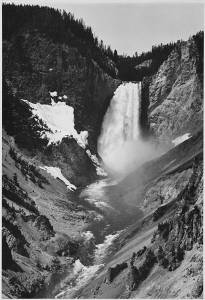
Adams was committed throughout his professional life to the promotion of photography as a fine art. In 1940, he helped to establish the photography department at the Museum of Modern Art, later co-curating its first exhibition Sixty Photographs: A Survey of Camera Aesthetics with the department's first curator Beaumont Newhall. In the years that followed, he developed a close friendship with Beaumont and Nancy Newhall, traveling with them to the Southwest and New England in the late 1940s. In addition to their work at the museum, Adams and Nancy Newhall collaborated in the 1950s and 1960s on several books and exhibitions.
Adams's willingness to share his knowledge of photography meant he was much in demand as a teacher and in 1941 he took up a teaching post at the Art Center College of Design in Los Angeles. The same year, Adams was commissioned to photograph the National Parks by Secretary of the Interior (Harold Ickes). The resulting photographs were meant to be printed at mural size and hung at the Washington D.C. Department of the Interior building. However, the project was halted later that year when funding for the project was withdrawn (an unforeseen consequence of America's participation in World War II). Though he never produced the large-scale prints for the Interior Department, Adams remained so committed to the project that he applied for, and received, a Guggenheim grant to complete the project in 1946. He created an enormous body of work for the project that was published as a book and a limited-edition portfolio.
Though his most important and influential work was probably behind him, in his later years Adams spent much of his time working on books of his photographs and reinterpreting his earlier negatives; very often to dramatic new effect. In 1952, with Beaumont and Nancy Newhall, Dorothea Lange, Minor White and others, he co-founded the high-end photography magazine Aperture. In 1967 he helped set up the Friends of Photography, a group founded to promote photography as a fine art. Adams remained an active member of the Sierra Club until 1971 (acting as its president from 1934). He died in Monterey, California in 1984, aged eighty-two. In his honor, a section of the Sierra Nevada mountains that he loved so much was renamed the Ansel Adams Wilderness shortly after his passing.
The Legacy of Ansel Adams
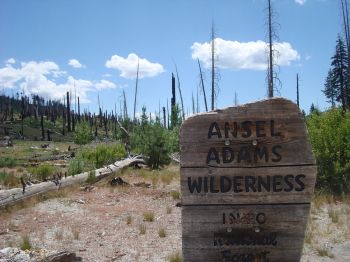
As a conservationist, writer, teacher, and photographer, Ansel Adams has been profoundly influential on future generations of artists, photographers, and environmentalists. There can be little doubt that he produced some of the most iconic images of the great American wilderness. Following in a long tradition of American landscape photographers, including Carleton Watkins, Eadweard Muybridge, Timothy O'Sullivan, and William Henry Jackson, Adams brought landscape photography into the realm of modernism by fusing technical precision with a profound and abiding love of the natural world. His work has inspired a range of artists and photographers working in the landscape tradition, from Eliot Porter and Robert Adams, to Edward Burtynsky and Richard Misrach. The subject of countless documentaries, books, essays, and exhibitions, Adams's images appear on living room and museum walls, proving that his photographs of the great American landscape continue to resonate. In 1980 Adams was awarded the Presidential Medal of Freedom by President Jimmy Carter. The award was in recognition of Adams's contribution to photography and the preservation of the great American landscape. In his citation, President Carter stated that "It is through [Adams's] foresight and fortitude that so much of America has been saved for future Americans."
Influences and Connections

- John Paul Caponigro
- Robert Adams
- Edward Burtynsky
- Richard Misrach
-
![Straight Photography]() Straight Photography
Straight Photography - New Topographics
Useful Resources on Ansel Adams
- Ansel Adams, an AutobiographyOur PickBy Ansel Adams and Mary Street Alinder
- Ansel Adams: A BiographyOur PickBy Mary Street Alinder
- Ansel Adams: Letters, 1916 - 1984By Andrea Stillman
- Looking at Ansel Adams: The Photographs and the ManBy Andrea G, Stillman
- Group f.64: Edward Weston, Ansel Adams, Imogen Cunningham, and the Community of Artists Who Revolutionized American PhotographyBy Mary Street Alinder
- The Negative: Exposure and DevelopmentBy Ansel Adams
- The Print: Contact Printing and EnlargingBy Ansel Adams
- Natural-Light PhotographyBy Ansel Adams
- Polaroid Land Photography Manual: A Technical HandbookBy Ansel Adams
- Camera and Lens: The Creative Approach, Studio, Laboratory, and OperationBy Ansel Adams
- Examples: The making of 40 photographsBy Ansel Adams
- This is the American EarthBy Ansel Adams and Nancy Newhall
- The Tetons and the YellowstoneBy Ansel Adams and Nancy Newhall
- Ansel Adams in Yosemite Valley: Celebrating the Park at 150By Peter Galassi
- Ansel Adams: The National Park Service PhotographsBy Alice Gray
- Ansel Adams at ManzanarOur PickBy Anne Hammond
- Ansel Adams: Divine PerformanceOur PickBy Anne Hammond
- Ansel Adams in the National Parks: Photographs from America's Wild PlacesBy Andrea Stillman
- Ansel Adams: Classic imagesBy John Szarkowski
- Ansel Adams at 100Our PickBy John Szarkowski
 Ask The Art Story AI
Ask The Art Story AI